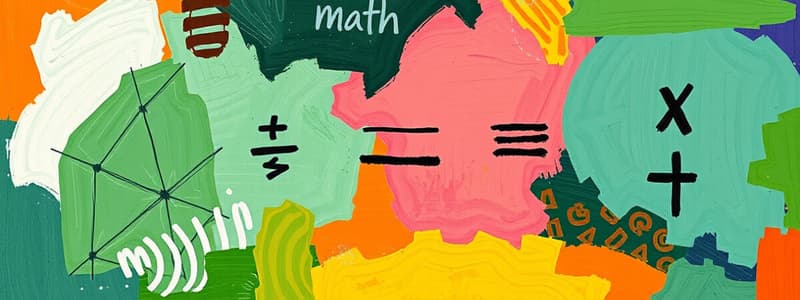Podcast
Questions and Answers
Which strategy involves breaking numbers apart for simpler subtraction?
Which strategy involves breaking numbers apart for simpler subtraction?
- Decomposition (correct)
- Counting on
- Regrouping
- Skip counting
What does the perimeter of a shape represent?
What does the perimeter of a shape represent?
- The space inside the shape
- The distance around the shape (correct)
- The area covered by the shape
- The total number of corners
Which of the following best describes multiplication?
Which of the following best describes multiplication?
- Splitting a number into equal parts
- Adding up all digits of a number
- Finding the difference between two numbers
- Repeated addition of the same number (correct)
What is a common method for visualizing multiplication?
What is a common method for visualizing multiplication?
Which attribute is NOT typically considered when identifying 2D shapes?
Which attribute is NOT typically considered when identifying 2D shapes?
Flashcards are hidden until you start studying
Study Notes
Standard 3 Math Study Notes
Addition and Subtraction
- Basic Concepts:
- Addition: Combining two or more numbers to get a sum.
- Subtraction: Taking one number away from another to find the difference.
- Key Skills:
- Mastery of addition and subtraction facts (up to 20).
- Understanding and using number lines for visual representation.
- Solving word problems involving addition and subtraction.
- Strategies:
- Use of counting on, counting back, and making ten for addition.
- Using decomposition (breaking numbers apart) for subtraction.
- Regrouping (carrying and borrowing) for multi-digit operations.
Multiplication and Division
- Basic Concepts:
- Multiplication: Repeated addition of the same number.
- Division: Splitting a number into equal parts or groups.
- Key Skills:
- Mastery of multiplication facts (up to 10 x 10).
- Understanding division as the inverse of multiplication.
- Strategies:
- Use of arrays (rows and columns) to visualize multiplication.
- Skip counting as a method for both multiplication and division.
- Solving simple word problems involving multiplication and division.
Shapes and Geometry
- Basic Concepts:
- Identification of 2D shapes (e.g., circles, squares, triangles, rectangles).
- Identification of 3D shapes (e.g., cubes, spheres, cones, cylinders).
- Key Skills:
- Understanding attributes of shapes (sides, angles, vertices).
- Recognizing symmetry and congruence in shapes.
- Introduction to perimeter (the distance around a shape) and area (the space inside a shape).
- Visual Tools:
- Use of drawings and models to represent shapes.
- Exploration of shapes in real-world contexts (e.g., buildings, objects).
Practice Tips
- Engage in practical activities such as using manipulatives for addition and subtraction.
- Use games and flashcards to reinforce multiplication and division facts.
- Explore nature and surroundings for identifying shapes and their properties.
Addition and Subtraction
- Addition involves combining two or more numbers to achieve a total sum.
- Subtraction is the process of removing one number from another to find the remaining difference.
- Master basic addition and subtraction facts up to 20 for fluency in calculations.
- Utilize number lines for a visual representation of adding and subtracting numbers.
- Solve word problems that require addition and subtraction strategies.
- Employ counting on, counting back, and the make ten strategy to simplify addition.
- Use decomposition, or breaking numbers into parts, to facilitate subtraction.
- Apply regrouping techniques, such as carrying and borrowing, for multi-digit arithmetic.
Multiplication and Division
- Multiplication is defined as repeated addition of the same number.
- Division entails dividing a number into equal portions or groups.
- Aim to master multiplication facts up to 10 x 10 for efficient problem solving.
- Understand division as the opposite of multiplication, which aids in grasping both concepts.
- Utilize arrays, arranged in rows and columns, to visualize multiplication.
- Implement skip counting as a method to perform both multiplication and division.
- Practice solving basic word problems which require the application of multiplication and division.
Shapes and Geometry
- Recognize and name basic 2D shapes such as circles, squares, triangles, and rectangles.
- Identify 3D shapes including cubes, spheres, cones, and cylinders.
- Learn to describe attributes of shapes, focusing on sides, angles, and vertices.
- Understand concepts of symmetry (matching sides) and congruence (identical shapes).
- Introduction to perimeter, which is the total distance around a shape, and area, the space contained within a shape.
- Leverage drawings and physical models to help illustrate and understand shapes.
- Explore geometric shapes within real-world contexts, such as architecture and everyday objects.
Practice Tips
- Use hands-on activities and manipulatives to assist in grasping addition and subtraction concepts.
- Enhance multiplication and division skills through interactive games and flashcards.
- Encourage exploration of the environment to identify and analyze various shapes and their characteristics.
Studying That Suits You
Use AI to generate personalized quizzes and flashcards to suit your learning preferences.




